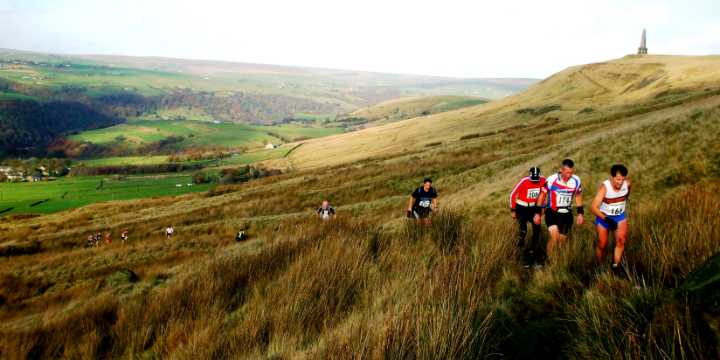
A Bumpy Transition from Road to Fell
Consider this Run Leeds peeps: the earliest competitive fellrunners ran naked. In all weather. And barefoot – across rock, between heather and through bog. Ok, some things have slightly changed since the 18th Century, but the basics of fellrunning are essentially still the same.
What is fellrunning? In basic form fellrunning may be described as a pursuit over varied terrain, using both defined rights of way and open land, where gradient will change, there will be exposure (without shelter) to the elements, and runners might be required to navigate between the start, pre-arranged checkpoints, and the finish. It can occur over Pennine moors, Welsh mountains or the Scottish Highlands (and Lowlands, that are also boggy, hilly and not really low).
Or more accurately, why does it differ from cross country or even trail running? Cross country running, traditionally, is held in grassy urban fields or parkland, and the route comprises laps, which means the surface iteratively deteriorates with repeated footfall towards the finish. Soft and muddy. At worst, cross country running will be undulating. Trail running, on the other hand, normally covers a route that has well-defined footpaths, tracks or wide bridleways; navigation skills are not usually required, but may be helpful. Trail events occur in both semi-urban and rural locations.
Fellrunning, confusingly, doesn’t always occur on a fell. The term ‘fell’ is synonymous with the Lake District, where a high proportion of clubs and races are staged. But fellrunning isn’t strictly geographical. Why? Well, for me fellrunning is never, ever, the same. Unlike road running – where, broadly speaking, a tarmac route on a hard, reliable surface is similar to other or previous efforts – fellrunning is unique: the terrain is constantly changing, likely in tandem with the weather, and the evolving challenges require greater thought than simply one stride followed by another.
Fell routes can contain diverse environments, including rock, moor, woodland and track; rock can then be further classified into shape, grip, size and movement – as a fellrunner attempts to scale up or career down scree will move en masse. The weather and the seasons will largely determine one’s speed, direction and overall effort. The scenery is emotive. Gone are the tedious tarmac training routes. Even if there is a demonstrable need to watch for the next precarious footstep, one or two glances from summits of ascents can make even the toughest races worthwhile.
No, really why? A significant proportion of race events are informal, non-commercial, facilitated by volunteers, and hardly ever for profit; many advertise all surplus cash will be directed to an associated local charity, and some support the nearest mountain rescue teams. Most races start (and end) at a pub. These pubs also act as Race HQs, changing rooms, parking, toilet facilities and post-race presentations. Some fell races even attempt to give prizes to all, while others provide soup or a beer as part of the entry fee. The entry fees are ridiculously low – ideal for Yorkshire folk or me as a thrifty tartan terror!
So, for a few quid you run up and then down a hill, and get a beer or some soup. Simple, huh? Frequently, this challenge comprises more than one hill – usually differing in gradient – and sometimes a race will comprise up and down, several times or more, on the same hill. There are additional challenges too: terrain, weather and navigation. These can mostly be mitigated by good planning and preparedness.
Here’s a myth buster: most fellrunners don’t actually run up the hills. Many – including me – will adopt a silent, single file of zombie-like shufflers, hands on knees and heaving air in and out of burning lungs. This is especially true of longer, multi-hill races where energy is distributed over a greater distance and time. I take these moments as opportunities to enjoy the view!
How do I start? Probably the best nugget of advice is to know your limits: if you’re new to running and have only recently built up sufficient stamina to tackle a 5km road route or parkrun, then attempting off-road running may be a huge leap. Perhaps first consider incorporating some hill repetitions into your running: between lamp-posts on a hilly street or discover a route, local to you, that includes a few steep inclines. A suitable pair of fell shoes and a decent waterproof jacket (with hood) will be an essential investment. The shoes should have a more ‘aggressive’ sole – larger rubber teeth for grip and stability – and the jacket must contain taped seams to comply with entry requirements. You will likely need other kit (waterproof bottoms, map, compass, and whistle) but fine to start with the basics.
Where is best? To try fellrunning you don’t need to travel to the Lake District, Snowdonia or Scotland. A number of suitable moor and woodland areas are easily accessible, by car, around the north and west of Leeds. Recommended areas would include Ilkley Moor, Withins near Howarth and Otley Chevin. Ilkley and areas around Hebden Bridge are also accessible by rail. A personal favourite, and excellent start, are the local trails through the Fulneck Valley, near Tong and Pudsey – try some of the short, sharp routes at Post Hill.
Fellrunning is fun – ascending makes me feel alive, while downhill involves going faster than I can sensibly control, windmilling with my arms and making whining noises (in my head anyway) that return me to a state of a child. Three years ago I completed my first race. Next month I’ll attempt the iconic Ben Nevis fell race. At no point have I been naked! But I do enjoy running free, almost wild. Soon, this could be YOU.